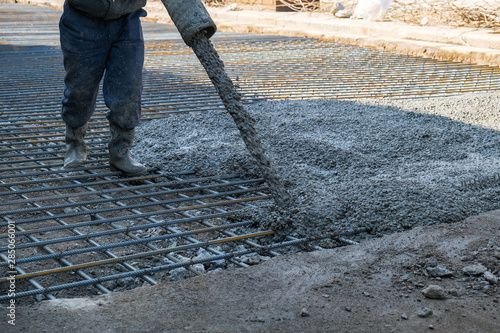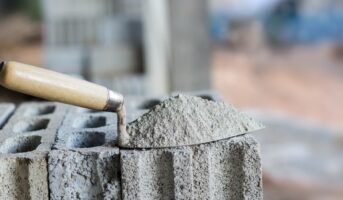The minimum strength that concrete must possess after 28 days of construction when quality control is carried out properly, is referred to as the grade of concrete. MPa, where M stands for Mix and MPa represents the overall strength, serves as the symbol for it. For instance, a grade of concrete with a strength of 20 MPa would be designated by the letters M20, where M stands for Mix and 20 is the concrete’s overall strength in Newton.
Sand is a fine aggregate, crushed stone is a coarse aggregate, and water is a major component of concrete. Binding materials like cement and lime are also important. The strength of the concrete changes depending on the ratio of the materials. Additionally, using the mix design process, it is feasible to establish the ratio of constituents for a specific strength.
According to the ratio of the grade of concrete, cement, sand, and aggregate are mixed in three categories and concrete grade ratio: Nominal grade, standard grade, and high strength concrete.
see also about self compacting concrete
Concrete grade: Types
Concrete ordinary mix grade
Concrete grades such as M5, M7.5, M10, M15, and M20 are referred to as nominal mix grades.
Standard concrete grade
Concrete grades such as M25, M30, M35, M40, and M45 are referred to as standard grades of concrete.
see also about: What is concrete, its types and composition
High-strength concrete grade
High-strength concrete is the grade of cement that goes by the names M50, M55, M60, M65, and M70.
known about: pcc concrete
Uses for concrete of different grades
- Ordinary grade: M5, M10, and M15 grades of concrete are typically utilised as the bed concrete beneath column footings in Plain Cement Concrete (PCC) projects. While RCC works (for moderate exposure), such as the construction of slabs, beams, columns, footings, etc., utilise M20 grade concrete.
- Standard grade: The standard grade of concrete includes M25, M30, M35, M40, and M45. The most common concrete grades used to build RCC constructions, including footings, columns, slabs, beams, etc., are M25 to M35. While commercial buildings, prestressed concrete members, runways, concrete roads, pressurised concrete girders, RCC columns, pressurised beams, etc., are built with higher grades like M40 & M45.
- High strength grade: RCC projects requiring high compressive strength, such as large structures, long-span bridges, construction in hostile environments, spillways of dams, etc., employ high-strength grades of concrete.
Concrete mix proportions for various concrete grades
Different concrete grades need various concrete mix ratios. In the construction of residential buildings, it is typically employed. Simple concrete grades include M5, M7.5, M10, M15, and M20 and are determined by the grade of concrete mix ratio determined by their nominal mix.
According to the concrete mix design, what constitutes standard grade and high-strength concrete is determined. Finding the ideal ratio of cement sand and aggregate for concrete to provide the desired strength in construction is known as concrete mix design.
To determine the correct mix percentage, the concrete mix design requires a number of calculations and laboratory tests. Additionally, the proper proportions of materials are provided, which makes concrete production inexpensive while maintaining the structural member’s requisite compressive strength. However, I’ve included here the concrete mix ratio for various grades of concrete.
1) The proportion of cement, sand, and aggregate in M5 grade concrete is one component cement, five parts sand, and ten parts aggregate.
2) The cement, sand, and aggregate mix ratio for M7.5 grade concrete is 1:4:8, with one component being cement. Sand makes up 4 parts and aggregates 8 parts.
3) The ratio of cement, sand, and aggregate in M10 grade concrete is one part cement, three parts sand, and six parts aggregate.
4) The cement, sand, and aggregate mix ratio for M15 grade concrete is 1 part of cement, 2 parts of sand, and 4 parts aggregate.
5) The cement, sand, and aggregate mix ratio for M20 grade concrete is one part cement, 1.5 parts sand, and three parts aggregate.
6) The cement, sand, and aggregate mix ratio for M25 grade concrete is 1 part of cement, 1 part of sand, and 2 parts aggregate.
learn about the fine aggregate
Concrete of the M20 grade
In RCC work for the construction of a building, structural members like compressive members footing, foundation, and column and flexural members like beam and slab, M20 grade of concrete are utilised as the minimum nominal mix of concrete.
Grade M20 concrete has qualities that increase compressive strength in 28 days after casting and adequate curing, where M stands for concrete mix design and 20 is a numerical value. Their value or compressive strength parameters are 20 N/mm2.
all about: PCC stands for Plain Cement Concrete

Source: Pinterest
See also: All about sand replacement method
Grade M20 concrete ratio
M20 grade concrete has a notional cement-to-sand-to-aggregate-to-water ratio of roughly 1:1.5:3, with the water-cement ratio being kept between 0.4 and 0.6. It is composed of a mixture of cement, sand (fine aggregates), and coarse aggregate.
M20 concrete mix ratio: M20 concrete is a 1:1.5:3 mixture of cement, sand, and aggregate, where cement makes up one part, sand makes up 1.5 parts, and aggregate or stone makes up the remaining three parts.
It entails mixing 1 bag of cement with 1.5 bags of sand and 3 bags of aggregate to produce concrete of the M20 grade.

Source: Pinterest
see also: curing of concrete
FAQs
Which concrete grade is utilised in plain cement?
In plain cement concrete, grades of concrete such as M5, M7.5, M10, and M15 are employed.
What are the uses of M20 and M25 grade concrete?
In RCC work, such as the construction of support structures such footings, foundations, columns, beams, and compressive structural life slabs, concrete of grades M20 and M25 and above is employed.
Housing News Desk is the news desk of leading online real estate portal, Housing.com. Housing News Desk focuses on a variety of topics such as real estate laws, taxes, current news, property trends, home loans, rentals, décor, green homes, home improvement, etc. The main objective of the news desk, is to cover the real estate sector from the perspective of providing information that is useful to the end-user.
Facebook: https://www.facebook.com/housing.com/
Twitter: https://twitter.com/Housing
Email: [email protected]











